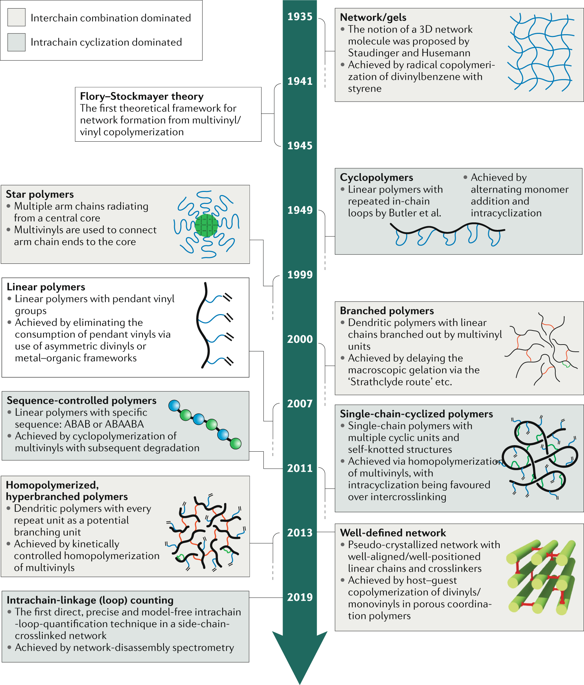Nature Reviews Chemistry ( IF 36.3 ) Pub Date : 2020-03-23 , DOI: 10.1038/s41570-020-0170-7 Yongsheng Gao 1, 2 , Dezhong Zhou 1, 3 , Jing Lyu 1, 4 , Sigen A 1 , Qian Xu 1 , Ben Newland 5 , Krzysztof Matyjaszewski 6 , Hongyun Tai 7 , Wenxin Wang 1, 4, 8

|
The construction of complex polymer architectures with well-defined topology, composition and functionality has been extensively explored as the molecular basis for the development of modern polymer materials. The unique reaction kinetics of free-radical polymerization leads to the concurrent formation of crosslinks between polymer chains and rings within an individual chain and, thus, free-radical (co)polymerization of multivinyl monomers provides a facile method to manipulate chain topology and functionality. Regulating the relative contribution of these intermolecular and intramolecular chain-propagation reactions is the key to the construction of architecturally complex polymers. This can be achieved through the design of new monomers or by spatially or kinetically controlling crosslinking reactions. These mechanisms enable the synthesis of various polymer architectures, including linear, cyclized, branched and star polymer chains, as well as crosslinked networks. In this Review, we highlight some of the contemporary experimental strategies to prepare complex polymer architectures using radical polymerization of multivinyl monomers. We also examine the recent development of characterization techniques for sub-chain connections in such complex macromolecules. Finally, we discuss how these crosslinking reactions have been engineered to generate advanced polymer materials for use in a variety of biomedical applications.
中文翻译:

通过多乙烯基单体的自由基聚合形成复杂的聚合物结构
具有明确定义的拓扑结构、组成和功能的复杂聚合物结构的构建已被广泛探索作为现代聚合物材料开发的分子基础。自由基聚合的独特反应动力学导致在单个链内的聚合物链和环之间同时形成交联,因此,多乙烯基单体的自由基(共)聚合提供了一种操纵链拓扑和功能的简便方法。调节这些分子间和分子内链增长反应的相对贡献是构建结构复杂聚合物的关键。这可以通过设计新单体或通过空间或动力学控制交联反应来实现。这些机制能够合成各种聚合物结构,包括线性、环化、支化和星形聚合物链,以及交联网络。在这篇综述中,我们重点介绍了一些使用多乙烯基单体的自由基聚合来制备复杂聚合物结构的当代实验策略。我们还研究了此类复杂大分子中子链连接的表征技术的最新发展。最后,我们讨论了如何设计这些交联反应来生成用于各种生物医学应用的高级聚合物材料。我们重点介绍了一些使用多乙烯基单体的自由基聚合来制备复杂聚合物结构的当代实验策略。我们还研究了此类复杂大分子中子链连接的表征技术的最新发展。最后,我们讨论了如何设计这些交联反应来生成用于各种生物医学应用的高级聚合物材料。我们重点介绍了一些使用多乙烯基单体的自由基聚合来制备复杂聚合物结构的当代实验策略。我们还研究了此类复杂大分子中子链连接的表征技术的最新发展。最后,我们讨论了如何设计这些交联反应来生成用于各种生物医学应用的高级聚合物材料。


























 京公网安备 11010802027423号
京公网安备 11010802027423号